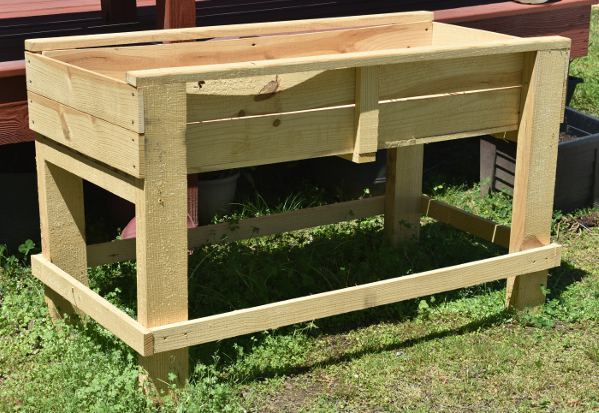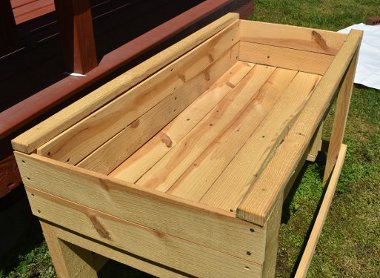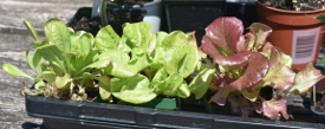

You may have heard of traditional raised bed gardening techniques or perhaps you’ve even been using them in your own garden. Those types of raised beds usually involve a frame or retaining wall being built around the area to be planted, usually out of wood, bricks, or stonework and then filled with a growing medium such as potting mix, amended soil, or a soiless mix.
Our Logical Insight Production Assistant, Eva, discovered a nearby lumber yard that was offering a different type of raised garden to their customers.
The enterprising lumber yard owner decided to put wood scraps left over from customer’s orders to good use to build these table-like structures for gardening. The raised planting area allows a gardener to group potted plants inside the platform or to plant items directly inside in the growing medium of your choice.

These are ideal for decks, patios, or in sunny areas of your yard to extend your gardening and floral display options. Folks who have trouble with all the bending and stooping that regular gardening usually entails would find the added height of the planting area much easier on their muscles and joints too.
Someone handy with woodworking tools would probably be able to make a structure similar to this model with a bit of thought and sweat equity. Perhaps you know of someone with the necessary skills who might be willing or could be bribed with a fresh batch of cookies or pizza bread?
The raised garden structure was delivered unfinished and only roughly sanded, so some prep work will be necessary before actually getting down to the planting part of the project.
To prolong the useful life of the raised garden, you’ll want to paint it with a garden-friendly paint or stain such as those that contain copper naphthenate. Not only will it help to preserve the wood, it also helps keep pests such as termites and other insects from causing damage. One brand found in hardware stores is Woodlife CopperCoat Garden Wood Preservative.
Tip: The copper naphthenate paint or stain can also help preserve and protect wooden stakes and trellises that you use in your garden. Give the items two coats of the paint or stain before deploying them to hold up your tomatoes or climbing flowers.
Other supplies to have on hand to finish your raised garden are sandpaper, landscape cloth for lining the planting area, and bags of the planting medium of your choice.
Raised Garden Specifications
For the model that Eva purchased the dimensions are:

The planting area depth for the model shown is 8 inches or 20.3 centimeters.
The eight inch depth of the interior planting shelf will accomodate shallow rooted vegetables or annual flowers. Lettuce, onions, scallions, and some types of herbs are all good vegetable candidates. Most small to medium sized annual flowers will also work. Examples are pansies, petunias, vinca, and dwarf varieties of snapdragons.

For larger vegetable plants such as cherry tomatoes, peppers, or small varieties of cucumbers, you’ll need a deeper planting area of about twelve inches minimum. Look for plant varieties that are recommended for container gardening.
We’ll be following along with each step as Eva preps and plants her raised garden structure. Be sure to check back for the follow-up articles and gardening tips!